Famen Temple Pagoda: A Pilgrimage to China’s Rich Buddhist Traditions
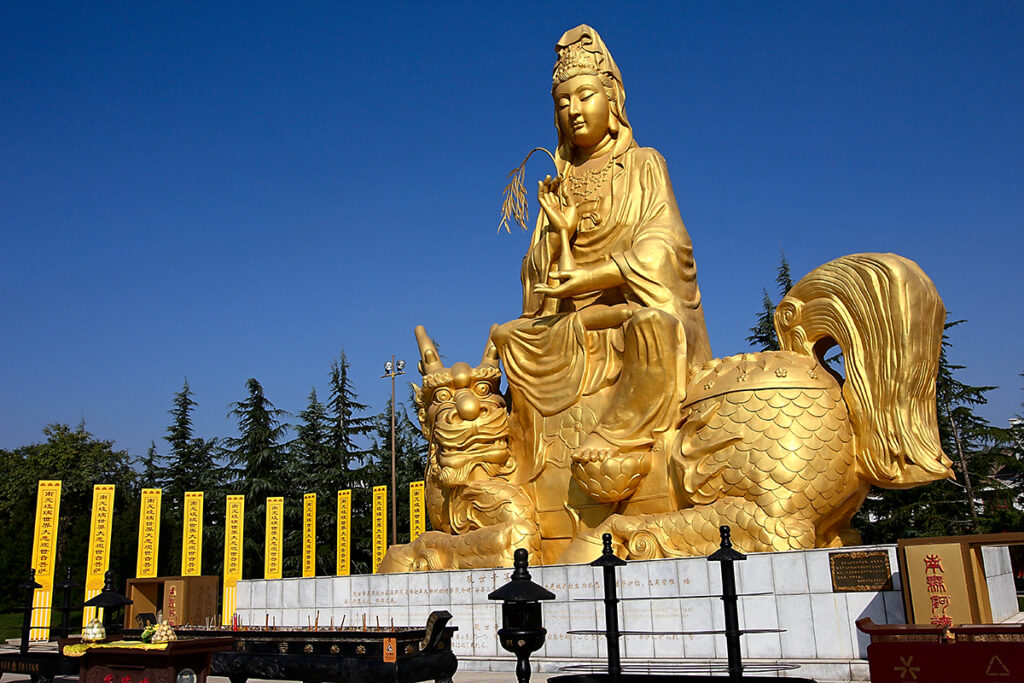
An Essential Guide to Visiting Famen Temple Pagoda
In This Guide
- An Essential Guide to Visiting Famen Temple Pagoda
- The Rich History and Legends of Famen Temple Pagoda
- Main Highlights: What You Absolutely Can’t Miss
- Planning Your Visit: A Practical Guide
- Tickets: Prices, Booking, and Tips
- How to Get There: A Complete Transportation Guide
- Local Cuisine and Accommodation Nearby
- Frequently Asked Questions
- Final Thoughts on Your Trip
Visiting the Famen Temple Pagoda is like stepping into a living tapestry of Chinese history, culture, and spirituality. Nestled in the tranquil Fufeng County of Shaanxi Province, this sacred site is renowned not only for its stunning architecture but also for its profound connection to Buddhism. As one of the most important Buddhist temples in China, Famen Temple serves as a custodian of ancient relics, including what is believed to be a true relic of the Buddha himself—a finger bone—discovered in the 1980s during a remarkable archaeological find.
The temple complex is adorned with a magnificent pagoda that stands as a testament to the craftsmanship of the Tang Dynasty. While the original structure succumbed to the ravages of time and natural disasters, the modern reconstruction is a marvel of contemporary architecture, attracting both pilgrims and tourists alike. Visitors are greeted by the majestic sight of the pagoda as they enter the expansive grounds, which are often bustling with worshippers and curious travelers.
What to Expect:

Famen_Temple_Pagoda.
-
Architectural Wonders: The Famen Temple Pagoda is not just a religious site; it is an architectural gem that blends ancient design with modern innovation. The juxtaposition of the old and new creates a unique visual experience.
-
Cultural Riches: The site houses a museum that showcases Tang Dynasty relics, providing deeper insight into the region’s rich history and the significance of Buddhism in Chinese culture.
-
Spiritual Atmosphere: As you wander through the temple grounds, you will encounter monks engaged in prayer, devotees lighting incense, and the serene ambiance that envelops this sacred space.
-
Relic Display: For those particularly interested in Buddhist artifacts, the “true relic” is displayed on select days, offering a rare glimpse into the treasures of the past.
Visiting Tips:
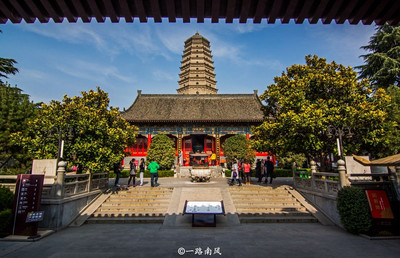
Famen_Temple_Pagoda.
-
Timing Your Visit: The relic is showcased only on weekends and public holidays, so plan accordingly to witness this extraordinary sight.
-
Transportation: Famen Temple is located a bit outside of Xi’an, making it essential to consider your transportation options in advance. Buses are available, but be prepared for varying schedules.
-
Cultural Etiquette: As a functioning temple, respect the spiritual practices of worshippers. Dress modestly and maintain a respectful demeanor as you explore.
In a world where ancient traditions often clash with modernity, Famen Temple Pagoda stands as a beacon of heritage, offering visitors a chance to experience the profound depths of Chinese religion and history. Whether you are a history buff, a spiritual seeker, or a curious traveler, a visit to Famen Temple will undoubtedly enrich your understanding of China’s cultural landscape.
The Rich History and Legends of Famen Temple Pagoda
Exploring the Rich History and Legends of Famen Temple Pagoda
Nestled in the serene landscape of Fufeng County, Shaanxi Province, Famen Temple Pagoda (法门寺塔) is not just a remarkable architectural feat; it is a treasure trove of history and Buddhist legends that date back over a millennium. Known as the “True Relic Pagoda,” this site is steeped in spiritual significance and captivating tales that continue to attract pilgrims and history enthusiasts alike.
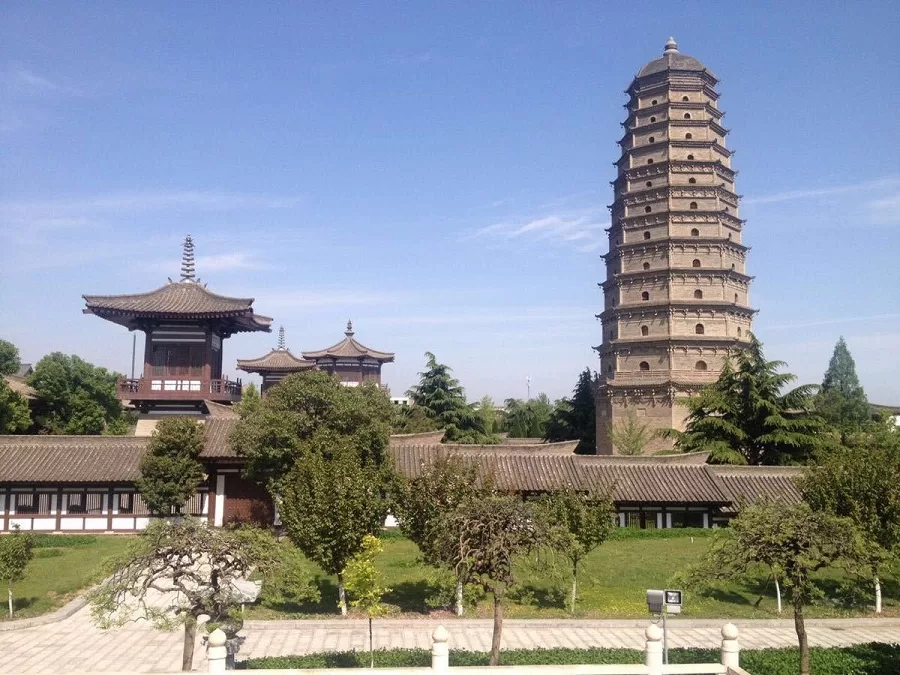
Famen_Temple_Pagoda.
A Historical Overview
Famen Temple’s origins trace back to the Eastern Han Dynasty (25-220 AD), but it gained prominence during the Tang Dynasty (618-907 AD). The temple is best known for housing what is believed to be a finger bone of the Buddha, a relic that was transported from India during the Tang period. This relic was discovered in 1981, following a flood that exposed the ruins of the ancient True Relic Pagoda, revealing a hidden underground palace filled with priceless Tang Dynasty artifacts.
The original pagoda was constructed in 349 AD but has undergone several reconstructions due to natural disasters, including fires and floods. The current structure, completed in 2010, stands as a modern interpretation of the ancient design, aiming to preserve the spirit of its predecessors while accommodating the needs of contemporary visitors.
The Legend of the True Relic
One of the most compelling stories associated with Famen Temple is the legend of the True Relic itself. According to Buddhist tradition, Emperor Gaozong of the Tang Dynasty commissioned the retrieval of the Buddha’s remains. After extensive searches, the finger bone was located and enshrined within the pagoda, transforming Famen Temple into a significant pilgrimage site.

Famen_Temple_Pagoda.
The relic not only symbolizes the essence of Buddhism but also serves as a reminder of the deep historical connections between China and India, the birthplace of Buddhism. Despite debates surrounding the authenticity of the relic, it remains a focal point of devotion, drawing countless worshippers who believe in its sanctity.
The Architectural Marvel
The modern pagoda, while striking in its contemporary design, pays homage to the architectural styles of the past. Its towering structure, adorned with intricate carvings and symbolic motifs, reflects the rich artistry of Buddhist culture. The pagoda’s design is complemented by a grand exhibition hall that showcases the relics and artifacts unearthed from the underground palace, allowing visitors to delve into the rich tapestry of Tang Dynasty history.
Cultural Significance
Famen Temple is not just a historical landmark; it is a living cultural site where ancient traditions continue to thrive. The temple hosts various ceremonies and festivals, including the annual Buddha’s birthday celebration, drawing visitors from near and far. Here, one can witness the fusion of spirituality and community, as locals and tourists alike participate in rituals, offering incense and prayers.
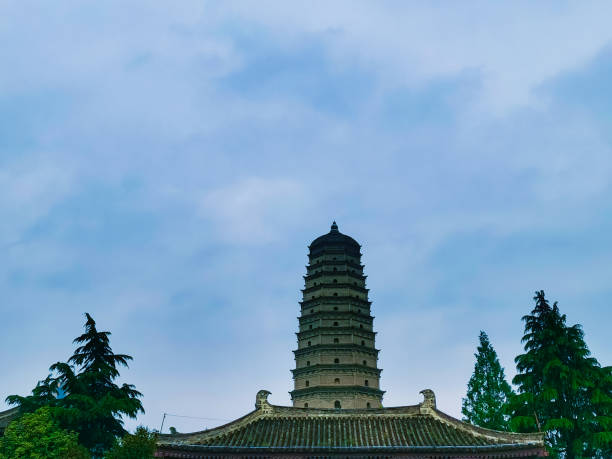
Famen_Temple_Pagoda.
Visiting Famen Temple Pagoda
For international travelers seeking a glimpse into China’s profound history and culture, Famen Temple Pagoda offers an enriching experience. While some reviews point to commercialization, the essence of the temple remains intact, and its historical narratives are compelling. Visitors are encouraged to explore not only the pagoda but also the surrounding museum, where artifacts tell stories of a bygone era.
In conclusion, Famen Temple Pagoda stands as a testament to China’s enduring spiritual heritage, embodying centuries of devotion, artistry, and the quest for enlightenment. Whether you’re a history buff, a culture enthusiast, or a spiritual seeker, the rich legends and vibrant history of this sacred site promise to leave an indelible mark on your journey through China’s storied past.
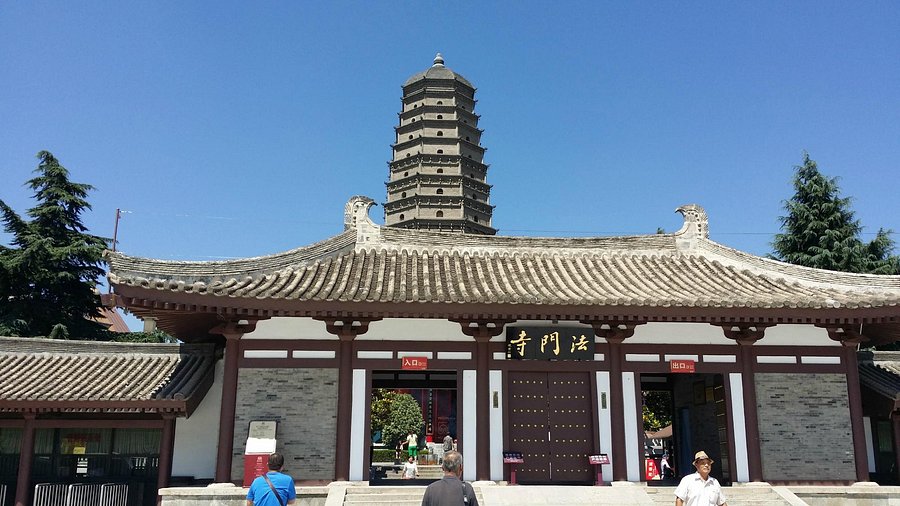
Famen_Temple_Pagoda.
Main Highlights: What You Absolutely Can’t Miss
Discover the Unmissable Highlights of Famen Temple Pagoda
Nestled in the tranquil landscape of Fufeng County, the Famen Temple Pagoda (法门寺塔) stands as a testament to China’s rich Buddhist heritage and architectural prowess. This revered site is not only a spiritual hub but also a treasure trove of historical artifacts. Here are the essential highlights that every traveler should explore:
1. The Magnificent Pagoda
One of the primary attractions is the New Famen Pagoda, a modern architectural marvel that reaches impressive heights. Completed recently, this pagoda houses the “true relic” of the Buddha—an artifact believed to be a finger bone of the Buddha himself, a claim that has stirred debate among historians. The striking design of the pagoda contrasts with the ancient elements of the site, making it a fascinating point of interest for architecture lovers.
2. The Underground Palace
Beneath the pagoda lies the Underground Palace, famously discovered after a heavy rain in 1981. This chamber is home to an array of Tang dynasty relics that were unearthed during excavations. Visitors can marvel at the exquisite craftsmanship of artifacts, including ancient scriptures and ceremonial items, which provide a glimpse into the spiritual life of the Tang era.
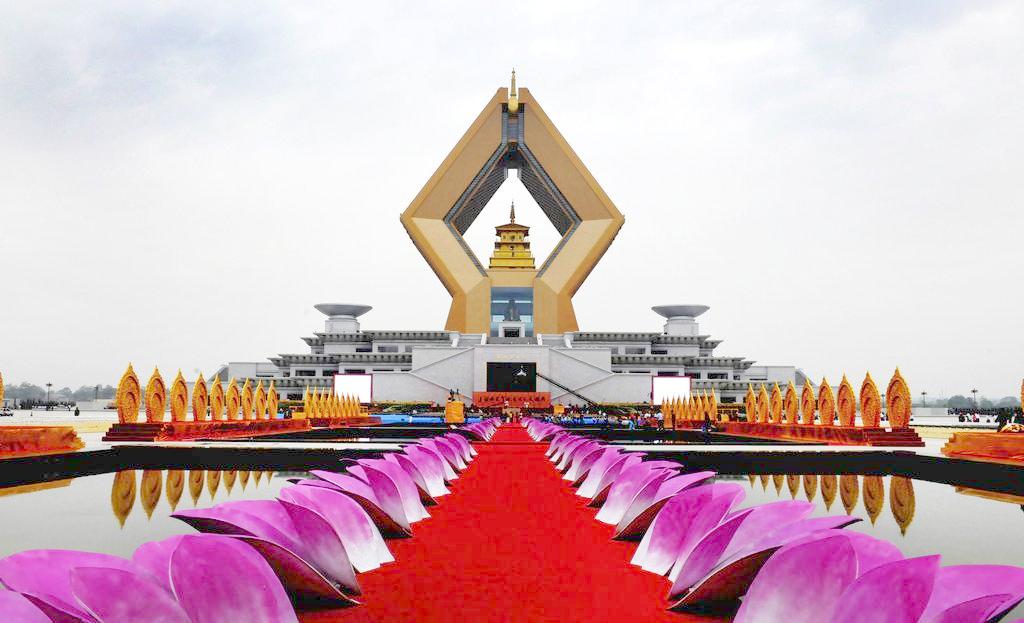
Famen_Temple_Pagoda.
3. The Temple Museum
The Temple Museum is another must-visit location. It showcases a plethora of relics found during the restoration process, including intricate sculptures and ceremonial objects that reflect the profound influence of Buddhism in ancient China. The museum is designed to enhance your understanding of the cultural and historical significance of the site.
4. The Historical Significance
Famen Temple holds a prominent place in Chinese history as it was a significant center for the dissemination of Buddhism during the Tang Dynasty. The temple complex, with its ancient structures and relics, narrates the story of how Buddhism integrated into Chinese culture. Take time to absorb the serene atmosphere, where worshippers still come to pay their respects.
5. The Rituals and Practices
Visitors to the temple may witness various Buddhist rituals in action. The sight of monks in prayer, the wafting incense, and the sound of chanting create a deeply spiritual environment. Participating in or observing these rituals can provide insight into the living traditions of Buddhism in China.
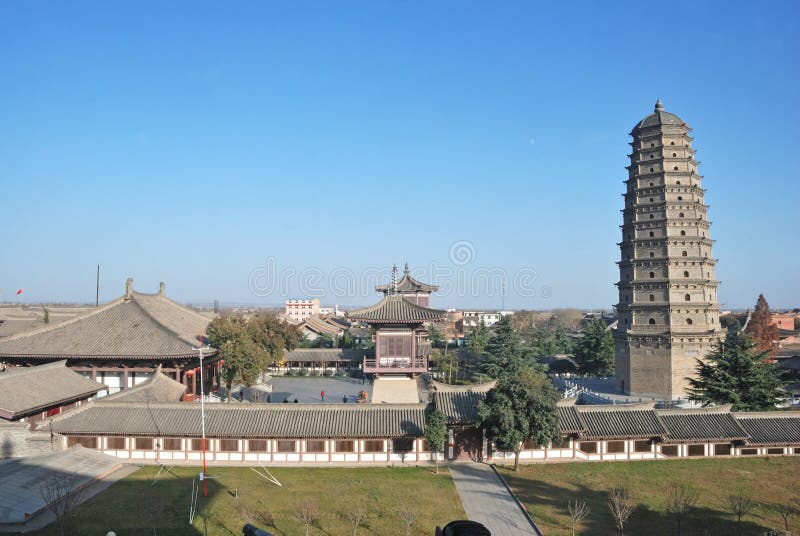
Famen_Temple_Pagoda.
6. Special Exhibitions
If your visit coincides with the weekend or certain lunar calendar dates, you may have the unique opportunity to see the “true relic” displayed in the underground chamber. This rare chance to view such a significant artifact draws many pilgrims and tourists alike. Note that access is limited on other days, so plan your visit accordingly.
7. Surrounding Attractions
The Famen Temple complex is surrounded by several other attractions that complement your visit. The Baoji Famensi Museum and the Treasure Hall of Famen Temple are located nearby, offering additional context and artifacts related to the site’s history. Taking a short stroll around these areas can enrich your understanding of the region’s cultural heritage.
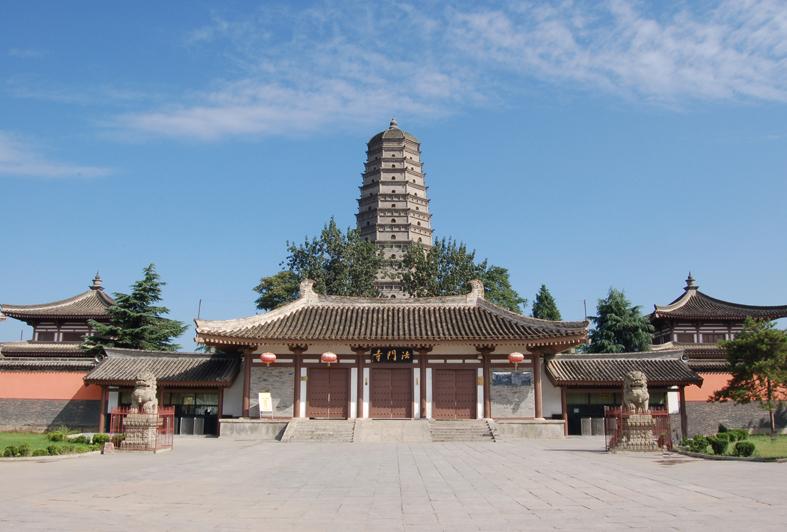
Famen_Temple_Pagoda.
8. Practical Information
- Opening Hours: The temple is open daily, from 8:30 AM to 6:00 PM.
- Entry Fees: While the entry fee covers the main attractions, additional donations may be requested for special access to certain exhibits.
- Travel Tips: Famen Temple is located about 120 kilometers from Xi’an. Consider joining a guided tour for convenience, or take public transportation for a more local experience.
Conclusion
Famen Temple Pagoda is not just a stop on your travel itinerary; it is a deep dive into the spirituality and history of Buddhism in China. Whether you are an avid historian, a culture enthusiast, or simply seeking tranquility, this sacred site offers a unique and enriching experience that you absolutely cannot miss.
Planning Your Visit: A Practical Guide
Visiting Famen Temple Pagoda: A Practical Guide
As you embark on your journey to one of China’s most significant Buddhist sites, the Famen Temple Pagoda, prepare to immerse yourself in a rich tapestry of history, culture, and extraordinary architecture. Located in Fufeng County, this temple is not only a testament to the artistry of the Tang Dynasty but also a center of spiritual significance, housing revered relics believed to belong to the Buddha. Here’s your essential guide for planning a visit.
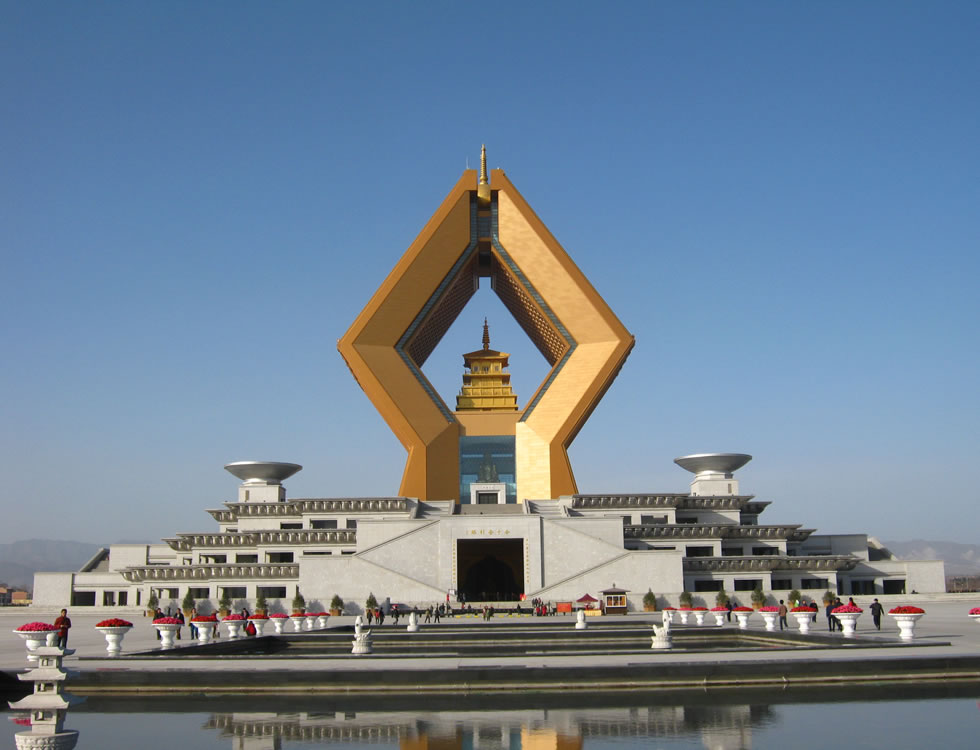
Famen_Temple_Pagoda.
Getting There
Location: Famen Temple is situated about 120 kilometers (75 miles) from Xi’an, making it accessible for a day trip.
Transportation Options:
– By Bus: Regular buses from Xi’an to Famen Temple are available. The journey takes approximately 1.5 to 2 hours. Ensure to check the latest schedules as they can be subject to change.
– By Private Car: If convenience is your preference, consider hiring a car or joining a guided tour that includes transportation.
– Metro to Bus Transfer: You can take the metro to HaiChengLu station, then transfer to a bus heading to the temple.

Famen_Temple_Pagoda.
Opening Hours
Famen Temple is open daily from 8:30 AM to 6:00 PM. However, note that some relics, including the highly coveted “true relic,” are only on display on weekends and specific days of the lunar calendar.
Admission Fees
The entrance fee is approximately CNY 180, which includes access to the temple grounds and the museum. Keep in mind that if you want to view the “true relic” on days it’s not regularly displayed, an additional donation may be required.
What to Expect
Architectural Marvels: The modern “relic tower” is a striking, albeit controversial, addition to the site. While some visitors appreciate its architectural design, others find it at odds with the ancient surroundings.
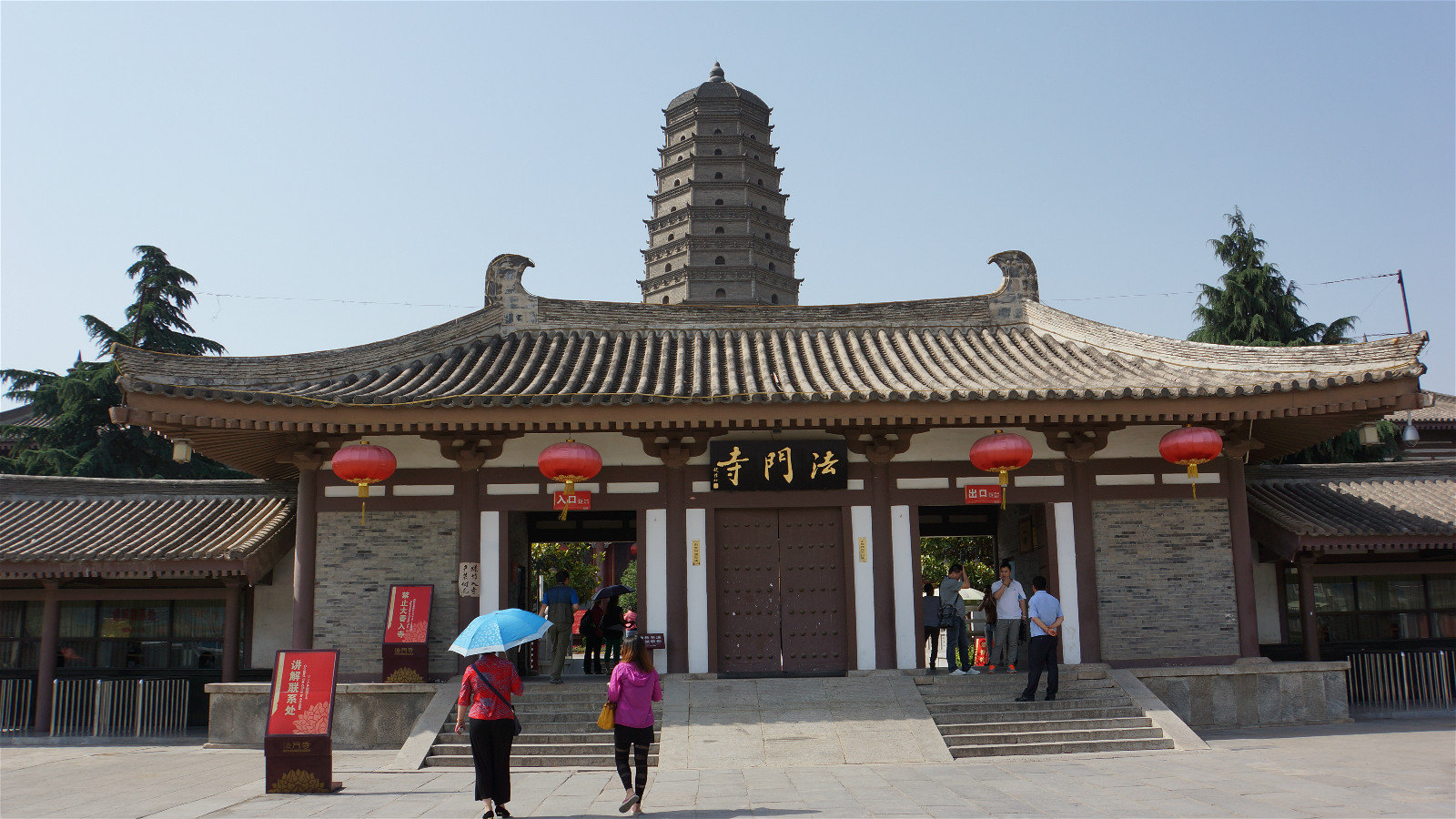
Famen_Temple_Pagoda.
Museum and Underground Palace: The on-site museum is a highlight, showcasing numerous artifacts from the Tang Dynasty. The underground chamber, which houses a collection of relics including what is claimed to be a finger bone of the Buddha, is particularly fascinating.
Spiritual Atmosphere: As an active place of worship, you will encounter monks and devotees practicing rituals, which adds to the serene atmosphere.
Tips for Your Visit
- Timing: To avoid large crowds, consider visiting on weekdays or early in the morning.
- Photography: While photography is allowed in most areas, be respectful of worshippers and follow local customs, especially in sacred spaces.
- Dress Code: Modest attire is recommended, as this is a functioning temple.
- Local Cuisine: Take advantage of the food options available on-site, where you can sample vegetarian meals that are both delicious and affordable.
Nearby Attractions
If time allows, explore the surrounding area:
– Baoji Famensi Museum: Located just a short walk from the temple, this museum offers more insights into the history of the site.
– Treasure Hall of Famen Temple: A specialty museum showcasing additional artifacts.
– Zhouyuan Museum: A history museum that further delves into the rich past of the region.
Final Thoughts
Visiting Famen Temple Pagoda is more than just a sightseeing excursion; it’s an opportunity to delve into the spiritual and historical depths of Chinese Buddhism. Whether you are a history buff, an architecture enthusiast, or seeking a moment of tranquility, this destination promises a memorable experience that connects you with ancient traditions and cultural heritage.
Tickets: Prices, Booking, and Tips
When planning a visit to the Famen Temple Pagoda, understanding the ticketing process and associated costs is essential for a smooth and enjoyable experience. Here’s everything you need to know about prices, booking options, and useful tips for your journey.
Ticket Prices
- Entrance Fee: The general admission fee for Famen Temple is CNY 180. This price includes access to the temple grounds and the main exhibits.
- Viewing the “True Relic”: If you are specifically interested in viewing the renowned “True Relic” believed to be a finger bone of the Buddha, be aware that this exhibit is only available on weekends and public holidays, as well as on the 1st and 15th days of the Lunar calendar. On these days, the entrance fee remains the same, but a donation may be requested for special access to this relic.
- Discounts: Check for any available discounts or special rates for students, seniors, or groups, as these can sometimes apply.
Booking Options
- Online Reservations: For convenience, tickets can often be purchased online through various travel platforms. This is a smart choice, especially during peak tourist seasons, to secure your spot and avoid long queues.
- On-Site Purchase: If you prefer spontaneity, tickets can also be purchased directly at the entrance. However, be prepared for potential wait times, especially during weekends and holidays.
Getting There
- Public Transport: Famen Temple is located about 120 kilometers from Xi’an. Buses are a common option, with tickets costing around CNY 37.5. The journey typically takes 1.5 to 2 hours. It’s advisable to check the bus schedule in advance to avoid long waits.
- Tours: Consider joining a guided tour that includes Famen Temple as part of a broader itinerary, such as visits to the Terracotta Army or other cultural sites in Xi’an. Tour prices vary but typically start around CNY 89 and include transportation and a guide.
Tips for Your Visit
- Timing: Aim to arrive early in the day to fully explore the temple grounds, museum, and exhibits. The temple opens at 8:30 AM and closes at 6:00 PM daily.
- Plan for Crowds: Weekends and holidays can attract large crowds, so if you prefer a quieter experience, try visiting during weekdays.
- Cultural Etiquette: Famen Temple is an active place of worship. Be respectful of the practices and rituals occurring during your visit. Observe local customs, such as removing shoes when entering certain areas.
- Photography: While many areas are photogenic, be mindful of signs related to photography, especially in areas where worshippers are present.
- Amenities: There are food and drink options available on-site, with reasonable prices. However, be prepared to use cash or local payment methods, as international credit cards may not always be accepted.
A visit to the Famen Temple Pagoda offers a fascinating glimpse into China’s Buddhist heritage and architectural marvels. With a little planning, you can make the most of your journey to this historic site.
How to Get There: A Complete Transportation Guide
Navigating Your Way to Famen Temple Pagoda
Famen Temple Pagoda, an essential stop for anyone interested in the rich tapestry of Chinese history and culture, is located in Fufeng County, Shaanxi Province. Its impressive architecture and profound historical significance make it a must-visit destination. Here’s how to reach this fascinating site, whether you’re starting from nearby Xi’an or other major cities.
Getting to Famen Temple from Xi’an
1. By Bus:
– Starting Point: Xi’an City Center
– Departure Location: The main bus station for Famen Temple is the Xi’an Long-Distance Bus Station (西安长途汽车站).
– Bus Schedule: Buses run frequently throughout the day, typically every 30 minutes. However, it’s advisable to check the latest schedule as it may vary.
– Travel Time: Approximately 1.5 to 2 hours.
– Cost: Around CNY 37.5 per person.
– Tip: It’s wise to arrive early, especially during peak tourist seasons, to secure a seat.
2. By Tour Package:
– Many tour operators in Xi’an offer day trips that include transportation to Famen Temple. These packages often combine visits to additional local attractions, such as the Terracotta Army or the City Wall.
– Cost: Prices vary, but you can expect to pay between CNY 100 to CNY 200 for a full-day tour, depending on inclusions.
3. By Private Car:
– If you prefer a more personal experience, consider hiring a car or taking a taxi from Xi’an. This option gives you the flexibility to explore at your own pace.
– Travel Time: Approximately 1 to 1.5 hours, depending on traffic.
– Cost: Expect to pay around CNY 300 to CNY 500 for a round trip, depending on your negotiation skills and the time of day.
Alternatives from Nearby Cities
From Baoji:
– By Bus: Direct buses to Famen Temple are available from Baoji, which is about 1 hour away. The cost is similar to that from Xi’an.
– Travel Tip: Check local bus schedules in advance, as they may not run as frequently as those from Xi’an.
From Other Cities:
– If traveling from cities like Chengdu or Luoyang, consider taking a high-speed train to Xi’an first, then follow the aforementioned bus or car options to Famen Temple.
Arrival at Famen Temple
Upon arrival, you’ll find that the temple complex is well-signposted, with clear directions leading you from the bus drop-off point to the entrance. The site is expansive, so wear comfortable shoes and be prepared to walk.
Opening Hours:
– Famen Temple is open daily from 8:30 AM to 6:00 PM. Plan your visit accordingly, especially if you wish to see the rare “true relics” on specific days.
Final Tips
- Language: English signage is limited, so having a translation app or a local guide can enhance your experience.
- Cash: While larger establishments may accept credit cards, it’s advisable to carry cash (CNY) for smaller purchases, especially if you plan to buy snacks or souvenirs.
- Cultural Sensitivity: Famen Temple is an active place of worship. Dress modestly and respect the customs of Buddhist practices observed at the temple.
Famen Temple Pagoda offers a captivating glimpse into China’s storied past, and with this guide, you’re well-equipped to make the journey effortlessly. Enjoy your exploration of one of the great treasures of Chinese culture!
Local Cuisine and Accommodation Nearby
When visiting the Famen Temple Pagoda, not only will you be immersed in the rich history and culture of this ancient site, but you’ll also have the opportunity to savor local cuisine and find comfortable accommodations nearby. Here’s a guide to enhance your experience in Fufeng County.
Local Cuisine
While exploring the area, don’t miss out on the chance to indulge in some delicious local dishes. Here are a few recommendations:
-
Vegetarian Meals at the Temple: Within the temple grounds, you can find simple yet delightful vegetarian meals. For around CNY 35, enjoy a wholesome meal that includes fresh vegetables and is light on oil—perfect for a nourishing lunch after your sightseeing.
-
Local Noodle Shops: Fufeng County boasts several noodle shops where you can savor hand-pulled noodles, often served in rich broths or stir-fried. Look for places that feature “biang biang noodles”, a regional specialty known for its wide, flat shape and chewy texture.
-
Street Food Stalls: As you wander the vicinity, keep an eye out for street food vendors offering snacks like baozi (steamed buns) and jiaozi (dumplings). These affordable treats are not only delicious but also give you a taste of local flavors.
Accommodation Options
After a day of exploration, you’ll want a comfortable place to rest. Here are some nearby accommodations that cater to various budgets:
-
Famen Temple Hotel: Located within walking distance from the temple, this hotel offers convenient access to the site and comfortable rooms. Guests appreciate the serene environment and friendly staff, making it an ideal choice for those who want to stay close to the action.
-
Shangri-La Hotel Baoji: A bit farther afield in Baoji, this upscale hotel provides luxurious amenities, including well-appointed rooms and exquisite dining options. It’s perfect for travelers seeking a more refined experience after their temple visit.
-
Budget Guesthouses: For travelers on a tighter budget, there are several guesthouses and hostels in Fufeng County. These offer basic amenities and a chance to meet fellow travelers. Look for places that have good reviews regarding cleanliness and hospitality.
Final Tips
-
Timing Your Visit: If you want to witness the “true relic”, plan your visit on a weekend or a public holiday, as it is displayed only during these times.
-
Transportation: Public buses connect Xi’an to the Famen Temple area, making it accessible for day trips. Be sure to check the bus schedules ahead of time to avoid long waits.
By combining your visit to the Famen Temple Pagoda with local culinary delights and comfortable accommodations, you’ll create a memorable journey steeped in the history and culture of this remarkable region. Enjoy your exploration!
Frequently Asked Questions
Frequently Asked Questions About Famen Temple Pagoda
1. What is Famen Temple Pagoda and why is it significant?
Famen Temple Pagoda (法门寺塔) is a renowned Buddhist site located in Fufeng County, Shaanxi Province. It’s famous for housing some of the most important relics of Buddhism, including what is believed to be a finger bone of the Buddha, discovered in the underground palace of the collapsed True Relic Pagoda. This site reflects the deep historical and cultural reverence for Buddhism in China, particularly during the Tang Dynasty.
2. What are the visiting hours for the temple?
Famen Temple is open daily from 8:30 AM to 6:00 PM. However, be aware that access to certain relics, such as the “true relic,” is limited to weekends, public holidays, and specific days of the lunar calendar (1st and 15th days).
3. How much does it cost to visit Famen Temple?
The entrance fee is CNY 180 (approximately $27) for adults. This ticket grants you access to the temple grounds and its main attractions, including the museum showcasing Tang Dynasty relics.
4. Is there public transportation available to Famen Temple?
Yes, visitors can take a bus from Xi’an to Famen Temple. The journey typically takes 1.5 to 2 hours. Make sure to check local schedules, as they can vary, and be prepared for potentially long wait times.
5. Are there any dining options available on-site?
Yes, there are several dining options at Famen Temple, offering reasonably priced meals. Visitors have noted that the meals are simple yet flavorful, making for a pleasant dining experience amidst the temple’s surroundings.
6. What should I know about the relics on display?
The “true relic” of the Buddha is displayed on specific days, but if you visit on a non-display day, you may still view it for a donation fee. The temple also features a museum that showcases a variety of archaeological finds, including precious relics from the Tang Dynasty.
7. Is Famen Temple suitable for tourists who are not interested in Buddhism?
While the temple is primarily a site of religious significance, its architecture, history, and the relics on display can be fascinating for any visitor interested in Chinese culture and history. However, some visitors have noted that the experience can feel commercialized, which might not appeal to everyone.
8. Can I participate in any cultural or religious activities while visiting?
Yes, Famen Temple is an active place of worship. Visitors may observe locals engaging in prayer and other religious practices. While participation is generally respectful and welcomed, it’s advisable to remain observant and considerate of the ongoing rituals.
Final Thoughts on Your Trip
As you reflect on your journey to the Famen Temple Pagoda, you’ll find it is a site steeped in both historical significance and spiritual resonance. Nestled in the heart of Fufeng County, this remarkable structure invites you to delve into the captivating stories of the Tang Dynasty and the enduring legacy of Buddhism in China.
A Blend of History and Spirituality
Visiting the Famen Temple is not just about witnessing architectural grandeur; it’s an opportunity to connect with a pivotal chapter in China’s religious and cultural history. The temple’s underground palace, home to the revered “true relics,” offers a glimpse into the rich tapestry of Buddhist tradition. The relics, believed to be the finger bone of the Buddha, serve as a bridge between the past and the present, allowing you to ponder the mysteries of faith and history.
Embrace the Experience
While some visitors may express concerns about commercialization, this aspect can be viewed as an opportunity to engage with the vibrant local culture. The temple grounds are bustling with life, from worshippers lighting incense to tourists exploring the impressive museum, which showcases invaluable artifacts from the Tang era.
Here are a few key takeaways to enhance your trip:
- Timing is Key: Plan your visit on weekends or during public holidays to see the “true relic” on display.
- Explore Beyond the Temple: Take time to wander around the museum and the surrounding areas, which are rich in history and offer additional insights into the relics and the site’s significance.
- Cultural Sensitivity: Be mindful of ongoing religious practices. The temple is an active place of worship, and respecting this atmosphere enriches your experience.
Conclusion
Your visit to the Famen Temple Pagoda will leave you with lasting memories and a deeper appreciation for China’s historical and spiritual heritage. Embrace the mix of ancient traditions and modern interpretations, and allow the stories of this remarkable site to resonate within you long after you leave. Whether you are a history enthusiast, a spiritual seeker, or an inquisitive traveler, Famen Temple offers a unique window into the eternal dialogue between culture and faith. Safe travels on your next adventure!